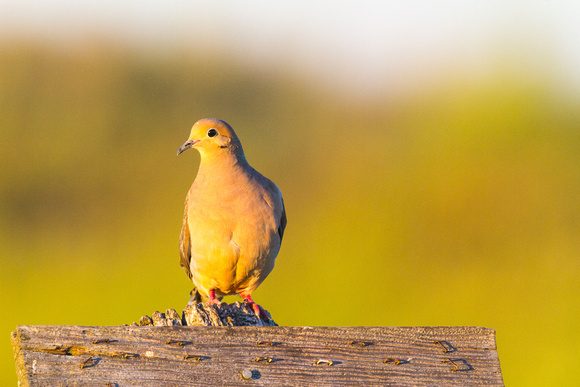I led a bird walk a couple of weeks ago and one of the participants pointed out a bird on a power line quite a distance away and said it was yellow. I put my binocs on it just as the Mourning Dove flew off.

Learning to identify birds is a fairly easy task if you put your mind to it. Way easier than figuring out the species of trees or wildflowers, the other common and popular subjects of nature study, for sure. You just have to learn a few tricks. I always ask a group I am leading what things to look for when identifying birds. Most often the first answer is color. At that point I take out a blue California Scrub Jay feather and hold it up. Everyone agrees to the blue color. Then I pass a few blue feathers around and ask people to hold it up to the light and look through it. It looks dark brown or black. That’s because there is no blue pigment in birds’ feathers. The color blue is cause by the refraction of light through the cells of the feather.

Birds make colored feathers by using pigments or pigments in combination with structure as in blue and iridescent colors. But the colors don’t always show the way you expect. Bright sunlight, like that shining on the dove on the wire, could be reflected as yellow, even off gray feathers. And birds in the shade won’t always show all their colors accurately. So I always tell the group that color is a bonus.
There is no one way to identify birds any more than there is one way to identify the make and model of an auto. It’s a combination of characteristics that distinguish one species from another. Things like size, shape and proportions, plumage coloration and pattern, behavior, and habitat all factor in. Beginning an identification by this method is often called GISS, General Impression of Size and Shape. The acronym GISS was first used in WWII to identify military aircraft. Birdwatchers also use JIZZ to mean the same thing. Without getting into the debate of JIZZ vs GISS, JIZZ seems to be the winner as it was first used to describe birds in 1921.
Be it GISS or JIZZ, either is only a beginning. If it’s walking through grass is probably not a duck or eagle and if it’s swimming and diving, you can rule out sparrows and woodpeckers. Ok, a bit silly, but you get the idea. You can eliminate a lot of possibilities by using JIZZ although there are times when it’s not all that handy, such as telling apart Cooper’s and Sharp-shinned Hawks, Lesser and Greater Yellowlegs, and Hairy and Downy Woodpeckers, and trying to ID a shorebird in a mixed flock.
Identifying birds just takes experience and a little guidance. What you need to do is to learn the most common birds so you can simply consider them background as you look for less common or rare species as they will stand out with a different GISS/JIZZ and details thereof.
Yes sir,
I was trying to obtain information on duck identification and was given this site as reference. Do you have any books solely relating to ducks?